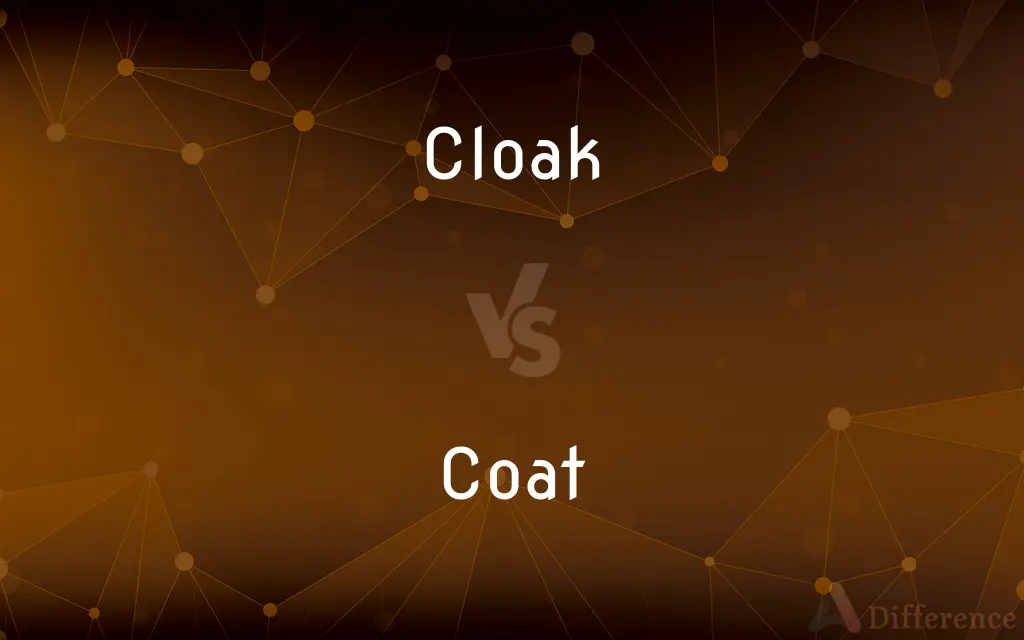Cloak vs. Coat — What's the Difference?
By Maham Liaqat & Urooj Arif — Updated on March 30, 2024
A cloak is a loose, sleeveless outer garment that drapes over the wearer's body, often fastened at the neck, while a coat is a long-sleeved outer garment that typically opens down the front and is more structured.

Difference Between Cloak and Coat
Table of Contents
ADVERTISEMENT
Key Differences
A cloak is a type of outerwear that dates back to ancient times, designed to cover the body from shoulders to varying lengths, usually without sleeves. It serves as protection against the elements and is often associated with historical or ceremonial use. In contrast, a coat is a staple in modern fashion, designed with sleeves and constructed to provide warmth and protection against cold weather. Coats come in various styles, lengths, and materials, tailored to different occasions and climates.
Cloaks are generally fastened at the neck and are free-flowing, allowing for a dramatic appearance and ease of movement. They can be made from a variety of materials, including wool, velvet, or synthetic fabrics, and may feature hoods or elaborate decorations. On the other hand, coats are more functional in design, equipped with buttons, zippers, or belts for closure, and often include features like pockets, collars, and linings for added warmth and convenience.
Historically, cloaks were essential for both men and women as versatile garments that could be easily draped over the body for warmth or protection from rain. They symbolize status or profession in some cultures. Meanwhile, coats evolved from practical garments designed for outdoor work and travel, to fashion statements that signify style, profession, or status, reflecting changes in fashion and societal norms.
The choice between a cloak and a coat can be influenced by factors like weather conditions, occasion, and personal style preferences. Cloaks offer an elegant, timeless appeal, suitable for formal events or costumes, providing a touch of mystique and romance. Coats, however, are essential for everyday wear, offering functionality and style in a wide range of settings, from casual to formal.
While both cloaks and coats serve as outerwear, their uses, styles, and cultural connotations vary significantly. Cloaks are often seen in historical reenactments or as part of fantasy and theatrical costumes, evoking a sense of the past or otherworldliness. Coats, conversely, are integral to contemporary fashion, providing practicality and versatility with a nod to current trends and individual expression.
ADVERTISEMENT
Comparison Chart
Sleeves
Sleeveless
Long-sleeved
Fastening
Typically at the neck
Buttons, zippers, belts down the front
Material
Wool, velvet, synthetic fabrics
Wool, cotton, synthetic fabrics, down
Function
Protection, ceremonial use, fashion
Warmth, protection against weather
Style
Loose, flowing, can include a hood
Structured, various styles and lengths
Historical Use
Ancient times, versatile garment
Outdoor work, travel, evolved with fashion
Modern Use
Formal events, costumes
Everyday wear, ranging from casual to formal
Cultural Connotation
Status, profession in some cultures
Style, profession, status
Compare with Definitions
Cloak
A sleeveless outer garment that drapes over the body, often fastened at the neck.
She wore a velvet cloak to the medieval fair, completing her ensemble.
Coat
A functional and fashionable item, often featuring pockets, collars, and linings.
The new coat had deep pockets and a warm lining, ideal for winter.
Cloak
A garment associated with historical or ceremonial occasions.
The king donned a ceremonial cloak for the coronation.
Coat
A piece of clothing that can vary in length, style, and material, suitable for different occasions.
His trench coat was perfect for the rainy weather.
Cloak
An outer garment that offers protection against the elements in a flowing form.
He wrapped his cloak tightly around him to shield against the cold wind.
Coat
A long-sleeved outer garment that opens down the front, designed for warmth and protection.
She buttoned up her coat as she stepped out into the snowy evening.
Cloak
A piece of clothing that adds a touch of elegance or mystery.
The character in the novel was always seen wearing a dark cloak, adding to his mystique.
Coat
A garment that evolved with fashion, reflecting personal style and societal norms.
Fashion designers have reinvented the coat this season with bold patterns and textures.
Cloak
A versatile garment used in various cultures for warmth or rain protection.
Travelers in the ancient world often wore cloaks as protection on their journeys.
Coat
Essential everyday wear that offers versatility from casual to formal settings.
For the formal event, he chose a sleek, tailored coat that complemented his suit.
Cloak
A cloak is a type of loose garment that is worn over indoor clothing and serves the same purpose as an overcoat; it protects the wearer from the cold, rain or wind for example, or it may form part of a fashionable outfit or uniform. Cloaks have been used by myriad historic societies; many climates favor wearing a full-body garment which is easily removed and does not constrain the wearer with sleeves.
Coat
A sleeved outer garment extending from the shoulders to the waist or below.
Cloak
A sleeveless outdoor overgarment that hangs loosely from the shoulders
He threw his cloak about him
Coat
See suit coat.
Cloak
Dress in a cloak
They sat cloaked and hooded
Coat
The hair or fur of an animal
A dog with a short coat.
Cloak
A long, loose outer garment, usually having a hood and no sleeves.
Coat
The outer covering of a biological structure or organ
A seed coat.
Cloak
Something that covers or conceals
A cloak of secrecy.
Coat
To cover with a layer
Dust coated the table. I coated the wall with paint.
Cloak
A long outer garment worn over the shoulders covering the back; a cape, often with a hood.
Coat
(countable) An outer garment covering the upper torso and arms.Wp
Cloak
A blanket-like covering, often metaphorical.
Night hid her movements with its cloak of darkness.
Coat
The outer covering of a virus.
Cloak
A cloakroom
Ground-floor accommodation comprises hall, cloaks, lounge, kitchen
Coat
A layer of material covering something else; a coating
A second coat of paint.
Cloak
To cover or conceal with a cloak or something that acts like a cloak
Mist that cloaks the mountains.
Coat
To provide or cover with a coat.
Cloak
(figurative) That which conceals; a disguise or pretext.
RQ:South Twelve Sermons
Coat
(countable) A covering of material, such as paint.Wp
Cloak
(Internet) A text replacement for an IRC user's hostname or IP address, making the user less identifiable.
Coat
(countable) The fur or feathers covering an animal's skin.Wp
When the dog shed its coat, it left hair all over the furniture and the carpet.
Cloak
(transitive) To cover as with a cloak.
Coat
Canvas painted with thick tar and secured round a mast or bowsprit to prevent water running down the sides into the hold (now made of rubber or leather).
Cloak
To cover up, hide or conceal.
Coat
(obsolete) A petticoat.
Cloak
To render or become invisible via futuristic technology.
The ship cloaked before entering the enemy sector of space.
Coat
The habit or vesture of an order of men, indicating the order or office; cloth.
Cloak
A loose outer garment, extending from the neck downwards, and commonly without sleeves. It is longer than a cape, and is worn both by men and by women.
Coat
A coat of arms.Wp
Cloak
That which conceals; a disguise or pretext; an excuse; a fair pretense; a mask; a cover.
No man is esteemed any ways considerable for policy who wears religion otherwise than as a cloak.
Coat
A coat card.
Cloak
To cover with, or as with, a cloak; hence, to hide or conceal.
Now glooming sadly, so to cloak her matter.
Coat
(transitive) To cover with a coating of some material.
The frying pan was coated with a layer of non-stick material, making it easier to wash.
Cloak
Anything that covers or conceals
Coat
(transitive) To cover like a coat.
Cloak
A loose outer garment
Coat
To clothe.
Cloak
Hide under a false appearance;
He masked his disappointment
Coat
An outer garment fitting the upper part of the body; especially, such a garment worn by men.
Let eachHis adamantine coat gird well.
Coat
A petticoat.
Coat
The habit or vesture of an order of men, indicating the order or office; cloth.
Men of his coat should be minding their prayers.
She was sought by spirits of richest coat.
Coat
An external covering like a garment, as fur, skin, wool, husk, or bark; as, the horses coats were sleek.
Fruit of all kinds, in coatRough or smooth rined, or bearded husk, or shell.
Coat
A layer of any substance covering another; a cover; a tegument; as, the coats of the eye; the coats of an onion; a coat of tar or varnish.
Coat
Same as Coat of arms. See below.
Hark, countrymen! either renew the fight,Or tear the lions out of England's coat.
Coat
A coat card. See below.
Here's a trick of discarded cards of us! We were ranked with coats as long as old master lived.
Coat
To cover with a coat or outer garment.
Coat
To cover with a layer of any substance; as, to coat a jar with tin foil; to coat a ceiling.
Coat
An outer garment that has sleeves and covers the body from shoulder down; worn outdoors
Coat
A thin layer covering something;
A second coat of paint
Coat
Growth of hair or wool or fur covering the body of an animal
Coat
Put a coat on; cover the surface of; furnish with a surface;
Coat the cake with chocolate
Coat
Cover or provide with a coat
Coat
Form a coat over;
Dirt had coated her face
Common Curiosities
What distinguishes a cloak from a coat?
The main distinction lies in their structure: cloaks are sleeveless and draped, while coats have sleeves and a more defined shape.
How has the design of coats evolved over time?
Coats have evolved from practical, outdoor garments to fashionable items that reflect current trends and individual styles.
Are there any cultures where cloaks are still commonly worn?
While not as common in daily wear, cloaks are still used in some cultures for ceremonial purposes or traditional dress.
Are coats suitable for all seasons?
Coats come in various materials and styles, making them suitable for all seasons, from lightweight options for spring to heavy, insulated ones for winter.
Can a cloak replace a coat in terms of functionality?
While cloaks can provide warmth and protection, coats offer more functionality with features like pockets and closures, making them more practical for everyday use.
What types of coats are popular in contemporary fashion?
Trench coats, parkas, pea coats, and puffer coats are among the popular styles in contemporary fashion.
Did cloaks serve a practical purpose in history?
Historically, cloaks were practical garments used for warmth and protection from the elements.
Can cloaks be worn in modern times?
Yes, cloaks can be worn for formal events, in theatrical costumes, or as a fashion statement.
Why might someone choose a cloak over a coat?
Someone might choose a cloak for its elegant appearance, historical significance, or for a specific occasion that calls for a dramatic look.
How do cloaks and coats reflect personal style?
Both can reflect personal style through material, color, and design choices, though coats offer more variety in modern fashion.
Share Your Discovery

Previous Comparison
Cathetus vs. Hypotenuse
Next Comparison
Esthetic vs. AestheticAuthor Spotlight
Written by
Maham LiaqatCo-written by
Urooj ArifUrooj is a skilled content writer at Ask Difference, known for her exceptional ability to simplify complex topics into engaging and informative content. With a passion for research and a flair for clear, concise writing, she consistently delivers articles that resonate with our diverse audience.















































